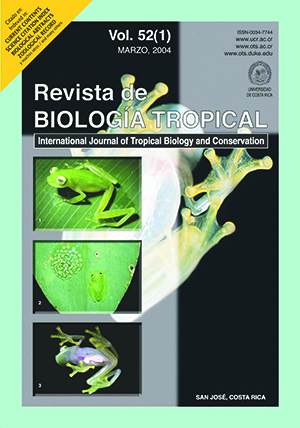Resumen
Para identificar las revistas, libros y personas más influyentes en la biología latinoamericana, se envió por correo electrónico una encuesta a 553 personas dedicadas el tema, según la base de datos de la Revista de Biología Tropical. Un tercio de ellas respondió, concluyéndose que la Revista de Biología Tropical, es la más influyente de la región según las personas consultadas. Con esta excepción, la mayoría de las revistas influyentes son publicadas en países desarrollados. La distribución temática de las respuestas y las evaluaciones independientes descartan la posibilidad de que este y los demás resultados resulten de un sesgo entre los científicos consultados por ser de alguna manera próximos a la revista. Temáticamente, se mencionaron especialmente revistas del área marina y ecológica. A diferencia de la ciencia estadounidense, no hay personajes ni libros influyentes que sobresalgan de manera apabullante. Los resultados resaltan la subjetividad de premios y calificaciones en este campo y posiblemente resulten de que no hay tradición de que mujeres y hombres de ciencia locales aparezcan frecuentemente en los medios de comunicación, la poca capacidad de difundir internacionalmente los resultados locales y la insignificante importancia que la cultura iberoamericana concede a la ciencia. También sugieren la necesidad de que las revistas latinoamericanas hagan un esfuerzo para llenar mejor las necesidades del aparato científico regional (buena atención a los autores, un estricto rechazo de los manuscritos de inferior calidad, y una distribución a tiempo y muy amplia de las revistas). La marcada dominancia del sexo masculino puede deberse a que hay pocas mujeres trabajando en este campo o a que ellas no sean percibidas como sobresalientes por razones de inequidad sociocultural. La predominancia de nacionalidades de las personas consideradas como influyentes en la ciencia latinoamericana calzan en general con los países que dominan la producción científica regional. El curioso hecho de que la revista más influyente sea editada en uno de los países más pequeños de la región podría deberse actualmente a la larga tradición de la revista y la escasa disponibilidad de otras alternativas con equivalente difusión y periodicidad, así como a su permanencia en los índices internacionales. Se recomienda que América Latina elija y fortalezca a sus mejores revistas y que desarrolle un panteón propio de héroes que, con el apoyo de los medios de comunicación de masas, sirvan de modelo a las nuevas generaciones.Citas
Anónimo. 2002. Perspectivas del medio ambiente mundial 2002, GEO-3. Pasado, presente y futuro. Programa de Naciones Unidas para el Medio Ambiente, Nairobi, Kenia. 446 p.
Calvo H., M. 2003. La noticia de ciencia en el tercer mundo. Universidad de Sao Paulo, Brasil (consultado el
octubre 2003, www.eca.usp.br/nucleos/njr/espiral- /morea15.htm).
CAPES (Coordinación de Perfeccionamiento de Personal de Nivel Superior). 2003. Periodicos. Ministerio de Educación, Brasilia (consultado el 01 Marzo 2004, http://www.capes.gov.br).
Castro, R.C.F. 1998. La representatividad de la literatura latinoamericana y del Caribe en la base de datos LILACS. Organización de Estados Americanos, Washington, D.C. (consultado el 9 de octubre 2003, www.science.oas.org/ricyt/biblioteca/documentos- /castro.doc).
Cazaux, D. 2002. Latindex: el índice de las publicaciones científicas latinoamericanas. Scientific American. Latinoamérica 1(2): 20-23.
Cohen, J.E., C. Small, A. Mellinger, J. Gallup & J. Sachs. 1997. Estimates of coastal populations. Science 278:
-1212.
Cole, S. 1975. Leakey’s Luck: The Life of Louis Seymour Bazett Leakey, 1903-1972. Collins, Londres. 448 p.
Fuentes, B. 1997. La ciencia en el tercer mundo. Bol. Soc. Mex. Física 10: 71-73.
Kruif, P. de. 1954. Microbe hunters. Harcourt Brace Jovanovich, Orlando, Florida. 337 p.
Hastings. P.A. & D.R. Robertson. 2001. Systematics of Tropical Eastern Pacific Fishes. Rev. Biol. Trop. 49(1): x-xii.
Monge-Nájera, J. 2002. Cómo hacer ciencia en los trópicos. Rev. Biol. Trop. 50: XIX-XXVIII.
Monge-Nájera, J. 2003. Os objetivo das revistas tropicales. Informatiovo da Sociedade Entomológica do Brasil 28(3): 1, 3.
Monge-Nájera, J., C. Benavides-Varela & B. Morera. 2003. Un nombre para Biología Tropical. Rev. Biol. Trop. 51: 617-620.
Morehouse, W. 1984. Fundamental research and frontier technologies in the Third World: new imperatives and new paradigms. Interciencia 9: 140-144.
Pacheco-Ruíz, I. & A.L. Quintanilla-Montoya. 2002. La revista Ciencias Marinas y su factor de impacto mundial / The journal Ciencias Marinas and its worldwide impact factor. Ciencias Marinas: 121-124.
Redondo B., L. 2003. Retos ante la Ciencia Política Tercermundista. La investigación. (consultado el 12
setiembre 2003, http://www.nodo50.org/cubasiglo XXI/politica/redondo3_310701.htm).
Salazar-Vallejo, S.I. & L.F. Carrera-Parra. 1998. Taxonomía biológica, factor de impacto y evaluación curricular para el siglo XXI. Interciencia 23: 293-298.
Summers, W.C. 1998. Microbe Hunters revisited. Internatl. Microbiol. 1: 65-68.
Vega, P. 2002. Nuevo espacio para la ciencia latinoamericana. Universidad Nacional Autónoma, México, D.F., México. (consultado el 12 setiembre 2003, http://www.jornada.unam.mx/2002/may02 /020520/cien-patricia.html).
Villarreal, A.L. 2001. Relaciones de poder en la sociedad patriarcal. Actualidades Investigativas en Educación,
Universidad de Costa Rica, San José, Costa Rica. (consultado 23 noviembre 2003, http://revista.iimec .ucr.ac.cr/articulos/1-2001/archivos/patriarcal.pdf).
Comentarios

Esta obra está bajo una licencia internacional Creative Commons Atribución 4.0.
Derechos de autor 2004 Revista de Biología Tropical


